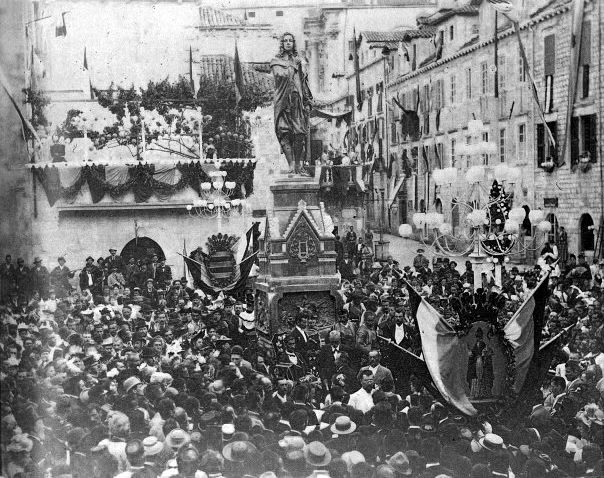Unveiling Of The Gundulić Monument on:
[Wikipedia]
[Google]
[Amazon]
 The unveiling of the Gundulić monument in
The unveiling of the Gundulić monument in
Dubrovnik
Dubrovnik (), historically known as Ragusa (; see notes on naming), is a city on the Adriatic Sea in the region of Dalmatia, in the southeastern semi-exclave of Croatia. It is one of the most prominent tourist destinations in the Mediterran ...
on May 20, 1893, was a symbolical event in the political history of Dubrovnik, since it brought to the surface the wider tensions between the two political sides of the city, the Croats
The Croats (; hr, Hrvati ) are a South Slavic ethnic group who share a common Croatian ancestry, culture, history and language. They are also a recognized minority in a number of neighboring countries, namely Austria, the Czech Republic, ...
and the Serb-Catholics in the pre-World War I
World War I (28 July 1914 11 November 1918), often abbreviated as WWI, was one of the deadliest global conflicts in history. Belligerents included much of Europe, the Russian Empire, the United States, and the Ottoman Empire, with fightin ...
political struggles in the region.
The preparation
At its session of March 9, 1880, the Municipal Council of Dubrovnik adopted the proposition received from the "Dubrovnik Youth", an organization known as part of theSerb-Catholic movement in Dubrovnik The Serb-Catholic movement in Dubrovnik ( sh-Cyrl-Latn, separator=" / ", Дубровачки србокатолички покрет, Dubrovački srbokatolički pokret) was a cultural and political movement of people from Dubrovnik who, while Catho ...
, to raise a monument for the 300th anniversary of the birth of Gundulić in 1888. The mayor of the city at the time was Rafael "Rafo" Pucić. It was decided that a five-member committee would be nominated to oversee the monument's construction. The members were esteemed intellectuals Medo Pucić
Orsat "Medo" Pucić, ( it, Orsatto Pozza, ; 12 March 1821 – 30 June 1882) was a Republic of Ragusa, Ragusan writer and an important member of the Catholic Serbs, Catholic Serb movement.
Biography
Orsat Pucić was born on in Dubrovnik, then in ...
, Pero Budmani
Petar "Pero" Budmani ( sr-Cyrl, Перо Будмани; 27 October 1835 – 27 December 1914) was a writer, linguist, grammarian, and philologist from Dubrovnik and a renowned polyglot.
Biography
Budmani was born in Dubrovnik/Ragusa, at the time ...
, Ivo Kaznačić, Mato Vodopić and Luko Zore. In 1882, the budget for the monument's erection was 11,000 florins.
In 1882, the oversight committee president Medo Pucić died, as did Ivan August Kaznačić in 1883. Mato Vodopić relinquished his membership when he was named Bishop
A bishop is an ordained clergy member who is entrusted with a position of authority and oversight in a religious institution.
In Christianity, bishops are normally responsible for the governance of dioceses. The role or office of bishop is c ...
in 1882, and Budmani also left the committee to focus on his work for the Academy's Dictionary; the work was hampered by lack of funding as well.
When the political coalition of the Serb-Catholic and Autonomist party members re-initiated work on it, the committee was reconstituted in 1891 with new members Marinica Giorgi, Lujo Bizzarro, Niko Bošković, Ivo Bogoević, Luko Bona, Brnja Caboga, Baldo Kostić, Vlaho Matijević, Jero Pugliesi, Stijepo Tomašević, Luko Zore and Nikola Ucov. The budget for the monument's erection was increased to 15,800 florins. The new committee organized new ways of funding, advertized the effort in newspapers and among various dignitaries, even reaching out to the emigrants in Argentina
Argentina (), officially the Argentine Republic ( es, link=no, República Argentina), is a country in the southern half of South America. Argentina covers an area of , making it the second-largest country in South America after Brazil, th ...
.
The construction was financed by King of Serbia Aleksandar Obrenović and among the others investors were Niko Pucić, who gave 5 florins, and Vlaho DeGiulli, who gave 10 florins.
The monument was erected on May 20, 1893, in Dubrovnik's largest square, Poljana. It was made by the Croatian sculptor Ivan Rendić. The official unveiling was scheduled for the next month.
The unveiling
The unveiling, like all the official celebrations in that period, was not only cultural, but also strongly national and political. The members of the Croatian Party of Rights and theCroatian People's Party
Croatian may refer to:
*Croatia
*Croatian language
*Croatian people
*Croatians (demonym)
See also
*
*
* Croatan (disambiguation)
* Croatia (disambiguation)
* Croatoan (disambiguation)
* Hrvatski (disambiguation)
* Hrvatsko (disambiguation)
* Se ...
together tried to bring to Dubrovnik as many Croats as possible from various Croat regions to give the Croatian national and political character to the celebration. On the other hand, the members of the Serb Party (Serb-Catholics) tried to gather as many Serbs-Catholics as possible to give a Serbian flavor to the celebration.
It was officially revealed on Sunday, July 26, 1893, by the last male member of the family, Baron Frano Getaldić-Gundulić (''see'' House of Gundulić). The celebration included more people from outside Dubrovnik than the citizens.
References
Sources
In Croatian: *Ivo Perić, ''Mladi Supilo'' (Young Supilo), Zagreb, 1996 *Newspaper ''Crvena Hrvatska'' (Red Croatia), Dubrovnik, No. 32, August 12, 1893, pp. 1–2. *Ivo Banac, ''Dubrovački eseji'' (Dubrovnik essays), Dubrovnik, 1992 * {{DEFAULTSORT:Unveiling of the Gundulic monument History of Dubrovnik Political history of Croatia 1893 in Croatia 1893 in politics Serb-Catholic movement in Dubrovnik